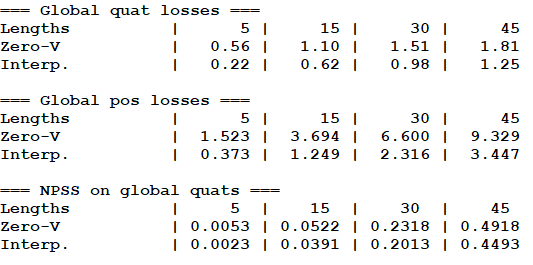Ubisoft La Forge Animation dataset and accompanying code for the SIGGRAPH 2020 paper Robust Motion In-betweening.
Shot in May 2017.
This dataset can be used under the Creative Commons Attribution-NonCommercial-NoDerivatives 4.0 International Public License (see license.txt).
If you use this dataset or transition benchmarking code, please consider citing the paper:
@article{harvey2020robust,
author = {Félix G. Harvey and Mike Yurick and Derek Nowrouzezahrai and Christopher Pal},
title = {Robust Motion In-Betweening},
booktitle = {ACM Transactions on Graphics (Proceedings of ACM SIGGRAPH)},
publisher = {ACM},
volume = {39},
number = {4},
year = {2020}
}
You may also want to consider the following papers, as they also use this dataset (or parts of it):
- Learned Motion Matching (Holden et al., 2020)
- Subspace Neural Physics: Fast Data-Driven Interactive Simulation (Holden et al., 2019)
- DReCon: Data-Driven Responsive Control of Physics-Based Characters (Bergamin et al., 2019)
- Robust Solving of Optical Motion Capture Data by Denoising (Holden, 2018)
- Recurrent Transition Networks for Character Locomotion (Harvey et al., 2018)
This repository contains large files, e.g. lafan1/lafan1.zip (137M). In order to clone this repository including the complete zip files, you need to use git lfs.
Example using Ubuntu 20.04:
curl -s https://packagecloud.io/install/repositories/github/git-lfs/script.deb.sh | sudo bash
sudo apt-get install git-lfs
git lfs install
git clone https://github.com/ubisoft/ubisoft-laforge-animation-dataset.git
If you do not have git lfs installed, you will see this error when trying to run evaluate.py:
BadZipfile: File is not a zip file
The animation data is contained in the lafan1.zip file.
All the animation sequences are in the BVH file format.
There are 5 subjects in the dataset, 77 sequences, and 496,672 motion frames at 30fps (~4.6 hours).
Every BVH file is named with the folowing convention: [theme][take number]_[subject ID].bvh.
Any sequences sharing the same theme and take_number were recorded at the same time in the studio.
Themes are high level indicators of the actions in the sequences.
The following themes are present in the LaFAN1 dataset:
| Theme | Description | Number of sequences |
|---|---|---|
| Obstacles | Locomotion on uneven terrain | 17 |
| Walk | Walking locomotion, with different styles | 12 |
| Dance | Free dancing | 8 |
| Fall and get up | Falling on the ground and getting back up | 6 |
| Aiming | Locomotion while handling or aiming a gun | 5 |
| Ground | Locomotion while crawling and crouching | 5 |
| Multiple actions | Miscellaneous/multiple movements per sequence | 4 |
| Run | Jogging/Running locomotion | 4 |
| Fight | Various fight movements | 3 |
| Jumps | Locomotion with one and two-leg jumps | 3 |
| Fight and sports | Fight and sports movements | 2 |
| Push and stumble | Pushing, stumbling and recovery | 3 |
| Push and fall | Pushing, falling, and getting up | 2 |
| Sprint | Sprinting locomotion | 2 |
| Push | Pushing adversary | 1 |
You should only need numpy installed in a python 3.X environment, but the code was developped with python 3.7 and numpy 1.17.4
You can easily create a test environement with conda :
conda create -n lafan_env python=3.7 numpy=1.17.4
From the command line:
python evaluate.py
To validate that the results produced by the baseline evaluations are within the expected ranges, you can subsequently run:
python evaluate_test.py
The first run may take several minutes, as it will compute the training statistics.
Following runs should go faster.
The training statistics for normalization are computed on windows of 50 frames offset by 20 frames.
We sample our test windows from Subject 5 at every 40 frames, and retrieve 2232 sequences for evaluation.
In the Zero-Velocity baseline, the last seed frame is repeated during the whole transition.
In the Interpolation baseline, the global root position is linearly interpolated (LERP), and quaternions are spherically linearly interpolated (SLERP).
You should obtain the following results:
When running the baseline evaluations, we report three different metrics on global quaternions on positions to assess the quality of the generated transition.
The global quaternion loss (L2Q) is the L2 distance computed between estimated and ground-truth global quaternion vectors g, averaged over each time step t and over all sequences s in the test set.
The global position loss (L2P) is the L2 distance computed between estimated and ground-truth normalized global position vectors p, averaged over each time step t and over all sequences s in the test set.
This is a distance metric based on the power spectrum of joint angles, as proposed by Gopalakrishnan et al. (2019).
It is reported to correlate better with human judgement about motion.
Its motivation and implementation details can be found in their paper.



